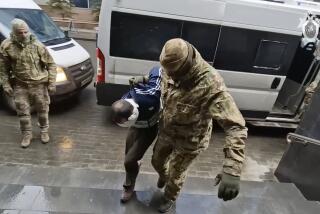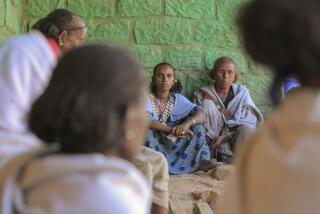Regional Outlook : Central Asian Republics Reap a Bitter Harvest : Poverty and hunger have followed independence. Networks that supplied life’s necessities ended with the Soviet Union.
- Share via
SUSAMYR, Kyrgyzstan — When the Soviet Union ceased to exist, the people of this remote herding settlement stopped getting cabbages, penicillin and most other necessities of civilization, which they had received under the vast Soviet distribution network.
Now most of the 7,000 residents survive on tea and bread made from their waning stores of flour. Wealthier families slaughter a lamb once a month or so to supplement their diets.
“People are barely making it,” sighed Kabylbek Tashtanbayev, 30, Susamyr’s head doctor. “But I’m afraid winter will mean hunger. These people are used to having the state helping them. They do not know how to help themselves.”
Winter arrives early and fiercely in these rugged mountains, and the coal that residents will need to heat their tiny mud-coated houses and barracks will cost more than they earn at the local collective farm, so many are collecting cow dung for fuel.
“They are heading for a crisis. I see no way out for them,” the settlement’s doctor said. “It’s very painful, and shameful for me to see my people sinking so low.”
The dire situation in Susamyr is just part of the deepening economic and social problems confronting the five Central Asian republics that constituted the poorest region of the old Soviet Union. Still, the Kremlin propped up local economies and provided medical facilities and education even to the most far-flung settlements in exchange for exploiting the region for valuable resources like natural gas, minerals, metals and cotton.
Now as these republics try to go it alone, they are being overcome by many of the scourges of the Third World:
* Poverty and unemployment have become widespread.
* Health and the quality of health care have dropped sharply because of crippling shortages of medical equipment and pharmaceuticals and environmental disasters.
* Local economies are breaking down without the structures of the Soviet Union and ties with enterprises in other republics.
* The drug trade is burgeoning as peasants realize there is no more profitable cash crop than opium.
* Clans and other primitive social structures are thriving in the power vacuum that exists in some republics, sometimes battling each other for influence and turf.
An Economy in Chaos
The woeful situation in the Central Asian republics is unlikely to improve soon, considering that most of them are experiencing severe economic crises.
The state banks have run out of money, so many workers and pensioners are broke.
Across Central Asia, enterprises are shutting down, production is plummeting and unemployment is soaring.
In no place is the situation worse than in Tajikistan, a small mountainous republic bordering on Afghanistan, where an estimated 40% of the republic’s 2.45 million working-age adults are jobless and 1,300 enterprises have already closed, said Khajimukhammad Umarov, director of Tajikistan’s Economics Institute and a leading free-market economist.
At Tajikistan Textile Machineworks in Dushanbe, the republic’s capital, a couple dozen women--many wearing the colorful traditional outfit of a calf-length dress over trousers--clamored for long-overdue wages.
Like many other factories in the region, Tajikistan Textile Machineworks had closed its operations for at least a month--putting its employees on forced vacation with no pay--because of the cash crisis.
“If we do not get the money from the bank, we will have a very difficult time bringing our employees back to work,” said Abdumansur Abdurashidov, the deputy directory for personnel.
The factory is already suffering because more than one-third of the staff--1,100 workers, 150 of them highly trained specialists--has left since 1990 as part of the regionwide flight of Russians and other European nationals.
The flight of skilled workers has brought the republic’s gold mining business almost to a halt, just at the time when Tajikistan needs its gold to attract foreign investments.
The newly independent governments in Central Asia have declared their intentions to abandon their Soviet-style economies--where the state is the only employer and sole owner of capital and property--but have made little progress.
“It is very difficult to start a market economy when there is massive poverty among the population,” said Yuri G. Alexandrov, a specialist in the Central Asian republics at the prestigious Moscow-based Oriental Institute.
Hunger and Illness
In Kyrgyzstan, perhaps the poorest of the former Soviet Central Asian republics, the smallest members of society feel the impact of the republic’s separation from the Soviet Union even before they take their first breaths.
At the intensive care unit of Maternity Hospital No. 2 in Bishkek, the Kyrgyz capital, a two-pound premature baby struggled to breathe from a respirator too large for her tiny body. In recent months, the hospital has seen more complicated births and underweight infants because their mothers are malnourished and sickly. The equipment to care for them is not available at the hospital, the best in the republic, doctors said.
“It is very difficult for me to face parents and say, ‘I cannot do anything to save your child because I do not have the right equipment,’ ” said Natalya Khasanova, 36, the hospital’s top intensive care specialist.
Babies’ problems do not end when they leave the hospital.
In some regions of Central Asia, as many as 6% of them die before age 1, six times as many as in America, local doctors say.
In Kazakhstan, the infant mortality rate is rising, health experts say, largely because of environmental health hazards posed by the nuclear industry in Semipalatinsk and at the Aral Sea, one of the world’s largest lakes, whose coastline has receded more than 60 miles because of abuse by Soviet authorities.
Residents of rural areas are suffering more than urbanites from the sudden disappearance of state support structures. “The herdsmen are in a difficult situation because of food shortages,” said Boris Shapiro, Kyrgyzstan’s deputy health minister. “Earlier, mobile stores traveled to them with flour, fruit and vegetables. But this has stopped because the independent Kyrgyz government cannot afford the gas.”
In Susamyr, local doctors say that hepatitis, tuberculosis and a variety of viruses are on the rise.
Across the border in Kazakhstan poor diets and bad sanitary conditions have contributed to a decline in public health. A few months ago, Kenen, a village of 3,000 in southern Kazakhstan, suffered a hepatitis epidemic because of contaminated water; several hundred children in the village were afflicted. When they were sent to a local sanitarium to be treated, many contracted tuberculosis.
“We have absolutely nothing, nothing in our supply cabinet. We have no antibiotics, no analgesics, no vaccines, no blood--we don’t even have bandages,” said Bubira Umarova, 36, a nurse in Kenen.
“Everything was fine until last year when the Soviet Union fell apart and everything started to disappear,” she added.
Batyr Tasambekov, Kazakhstan’s deputy health minister, said the republic only has about 20% of the pharmaceuticals it needs.
Because of reduced supplies, hospitals have put off all non-emergency operations.
Drug Problems
No Central Asian republic has yet pursued land reform. Leaders fear that selling land to peasants could spark territorial wars among the clans, which still play a powerful role in society. Also, directors of collective farms have emerged as powerful feudal lords who do not want to give up their fiefdoms.
Deep in the mountains of western Tajikistan, Pakhim Aslidimov rules over Khudjand, a collective farm village with 22,000 cattle and 1,500 residents.
Most of the peasants live in shabby mud-covered structures, without modern stoves, refrigerators or plumbing. Aslidimov’s house, however, is made of several separate buildings, with elaborate wood carving, lush Oriental carpets and modern appliances.
The children of the village play in filthy clothing and poorly fitting footwear and have only traveled by foot or donkey. Aslidimov rides around in a big car and goes abroad almost every year.
“This will remain a collective farm,” Aslidimov said. “If privatization is attempted, it will spark a war over this land. Besides, we all live well here--we all live equally--why change it?”
In the flatlands north of the mountains, Uzbekistan is trying to find a compromise. The land has been rented out to members of the collective farm.
“If you can work hard, then you can earn well,” said Khasan Tusonov, 30, a young farmer who has rented four acres to raise cotton at the Turayev Collective Farm. “Before I was part of a brigade and they told me when to work and how to work. Now I’m the boss.”
While Tusonov and his family are setting out to make their fortune in cotton, many peasants in Central Asia have been lured into growing a more profitable cash crop--opium.
“Criminal groups persuade peasants in mountainous regions to grow it and then they bring it out by car or by foot,” Jurabek Aminov, first deputy chief of Tajikistan’s national security agency, said.
Herdsmen in the remote, mountainous regions of Tajikistan and Kyrgyzstan grow fields of poppies, extract a milky juice from the capsule-like immature poppy fruits and sell the raw opium to a growing network of drug traders, according to law enforcement officials and residents in one of the regions where opium is grown.
As little as five years ago, officials said, opium was grown in this region only for folk medicine.
“But now, Tajikistan can be included in the ranks of countries that are developing into narcotics producers,” Aminov said. “This is a problem of poverty. The peasants realize it’s easier and more profitable to grow poppies than to do anything else.”
Most of the opium is exported to other parts of the former Soviet Union and abroad. But there are growing numbers of local drug addicts. Tajikistan has 1,900 officially registered opium addicts, according to the Interior Ministry.
Tajikistan has also become a key transit point for Afghan opium. Tajikistan’s 1,184-mile border with Afghanistan is poorly guarded, especially in the rugged Pamir mountains, so getting drugs across the border can be as easy as tossing a bundle across a narrow stream.
And now, Aminov said, opium growers and smugglers protect their fields with the machine guns that were disseminated by the authorities during a coup attempt this spring.
Clan Warfare
These weapons have also ended up in the hands of Tajikistan’s rival clans and political groups, turning their skirmishes into all-out warfare.
Because of the chaotic situation in the republic, one well-armed group calling itself the Youth of Dushanbe was able to take over the residence of the republic’s old-style Communist president, Rakhman Nabiyev, and then, last week, force him to resign.
Meanwhile, the violence between various Tajik clans escalated and reached new extremes of gruesomeness. An article in the influential Russian newspaper Izvestia reported Sept. 7 that the streets in the Tajik city of Kurgan Tyube were strewn with corpses “swelling and rotting in a horrible heat wave.”
“The conflicts here are not between various nationalities, as in other places of the former Soviet Union, but between groups of Tajiks,” Davlat Khudonazarov, a leading Tajik opposition politician, said.
When the Soviet Union was strong, the military and police stamped out clan violence, but the current government does not control it.
With clan warfare has come a growing refugee problem.
For the past few weeks, the Rakhmatulayevs--who fled warfare in Tajikistan’s southern Kurgan Tyubinsky region--have been spending one night in an overcrowded home of friends or relatives in Dushanbe and then moving on to the next home.
“Those who don’t run get killed,” said Rasul Rakhmatulayev, 53, a doctor. “We called our neighbors and found out that everything we accumulated in 24 years of married life has been stolen and our home has been taken over. We have nothing to go back to.”
Rakhmatulayev, like many other people here, blamed the current unrest on the fall of the Soviet Union.
“If something like this happened when the Soviet authorities were in charge, those at fault would be arrested and the situation quieted down,” Rakhmatulayev said. “Now it’s just anarchy here. We thank God that there was a Soviet Union. We don’t need this kind of democracy.”
The chorus of voices bemoaning the death of the Soviet Union seems almost unanimous in the former Central Asian republics. Independence was thrust upon them by the Slavic republics in December, and many people believe that nothing positive has come from it.
“This was not the Third World when the Soviet Union still existed--but it’s the Third World now,” Khudonazarov said.
Suffering in Central Asia
Without the Kremlin aid that once subsidized them, the five republics that made up Soviet Central Asia face deepening economic and social problems.
More to Read
Sign up for Essential California
The most important California stories and recommendations in your inbox every morning.
You may occasionally receive promotional content from the Los Angeles Times.













